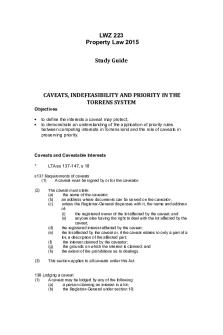Study Guide 11 PDF

| Title | Study Guide 11 |
|---|---|
| Course | Foundations of Learning |
| Institution | University of New Brunswick |
| Pages | 2 |
| File Size | 104 KB |
| File Type | |
| Total Downloads | 41 |
| Total Views | 147 |
Summary
Study Guide 11 for Foundations of Learning.
Textbook: Behaviour Analysis and Learning (5th Ed) by Pierce and Cheney...
Description
NAME:__________________________________________________
PSYC 2613
Study Guide 11 Ch. 12
1. What is language and verbal behavior? How does verbal behavior differ from language? Language is a poorly defined concept that can refer to linguistic habits, universal grammar, vocabulary, syntax, and meaning of communication. Verbal behavior deals with the performance of a speaker and the environmental conditions that establish and maintain such performance. Verbal behavior focuses on the function of what we say. 2. How did Skinner describe the differences between the behavior of listener and speaker? Skinner used the term rule-governed behavior to describe the behavior of the listener and verbal behavior to describe the behavior of the speaker. Rules are complex verbal discriminative stimuli for the listener, and the principles that govern stimulus control also regulate the rule-following behavior of the listener. Verbal behavior is shaped by subtle contingencies of reinforcement mediated by the behavior of the listener. 3. Define the following concepts: a. Manding: verbal operants whose form is regulated by establishing operations and maintained by specific reinforcement. b. Tacting: verbal operants whose form is regulated by nonverbal discriminative stimuli and maintained by generalized conditioned reinforcement from the verbal community. c. Intraverbal - How does an intraverbal response differ from an echoic response? An intraverbal does not involve a point-to-point correspondence between the verbal stimulus and the response. When point-to-point correspondence exists, this is termed echoic behavior (also needs formal similarity). d. Echoic - Identify the two requirements for a response to be considered echoic behavior. 1. point-to-point correspondence 2. formal similarity, meaning that the behavior occurs in the same mode (auditory or visual) as the stimulus. 4. How is textual behavior different than an echoic? Textual behavior requires a point-to-point correspondence, but not formal similarity. 5. What is an autoclitic and what are the five categories of autoclitic relations? Autoclitic: form of verbal behavior that modifies the consequences produced by other verbal responses and is used in conjunction with, and controlled by, primary verbal units (mands, tacts, and intraverbals). The five categories of autoclitic relations are descriptive, qualifying, quantifying, manipulative, and relational.
NAME:__________________________________________________
PSYC 2613
6. Identify and define the three basic classes or types of equivalence relations. symmetry—when stimulus class A is shown to be interchangeable with stimulus class B reflexivity or identity—the A to A relation transitivity—if A = B and B = C, then A = C. 7. What is an interlocking contingency? Show how both mand and tact relations are part of interlocking contingencies. An interlocking contingency involves the intermingling of behavior chains during social interaction in which each person’s verbal responses function as discriminative stimuli and reinforcement for the other person’s behavior.
Self-Rating Preparedness: 0 Participation: 0
.5 .5
1 1
1.5 1.5
2 2
2.5 2.5
Clarification Questions In the space below, provide any question about a topic that you would like clarification on....
Similar Free PDFs

Chapter 11 Study Guide
- 11 Pages

Oblicon Study Guide (11)
- 2 Pages

Chapter 11 - study guide
- 12 Pages

Study Guide Chapter 11
- 2 Pages

Chapter 11 Study Guide
- 1 Pages

Study Guide 11
- 2 Pages

Chapter 11-study guide
- 12 Pages

Chapter 11 study guide
- 25 Pages

Ch 11 study guide
- 5 Pages

Quiz 11 Study Guide
- 2 Pages

Chapter 11 Study Guide - biology
- 2 Pages

Acct Chapter 11 Study Guide
- 9 Pages
Popular Institutions
- Tinajero National High School - Annex
- Politeknik Caltex Riau
- Yokohama City University
- SGT University
- University of Al-Qadisiyah
- Divine Word College of Vigan
- Techniek College Rotterdam
- Universidade de Santiago
- Universiti Teknologi MARA Cawangan Johor Kampus Pasir Gudang
- Poltekkes Kemenkes Yogyakarta
- Baguio City National High School
- Colegio san marcos
- preparatoria uno
- Centro de Bachillerato Tecnológico Industrial y de Servicios No. 107
- Dalian Maritime University
- Quang Trung Secondary School
- Colegio Tecnológico en Informática
- Corporación Regional de Educación Superior
- Grupo CEDVA
- Dar Al Uloom University
- Centro de Estudios Preuniversitarios de la Universidad Nacional de Ingeniería
- 上智大学
- Aakash International School, Nuna Majara
- San Felipe Neri Catholic School
- Kang Chiao International School - New Taipei City
- Misamis Occidental National High School
- Institución Educativa Escuela Normal Juan Ladrilleros
- Kolehiyo ng Pantukan
- Batanes State College
- Instituto Continental
- Sekolah Menengah Kejuruan Kesehatan Kaltara (Tarakan)
- Colegio de La Inmaculada Concepcion - Cebu



